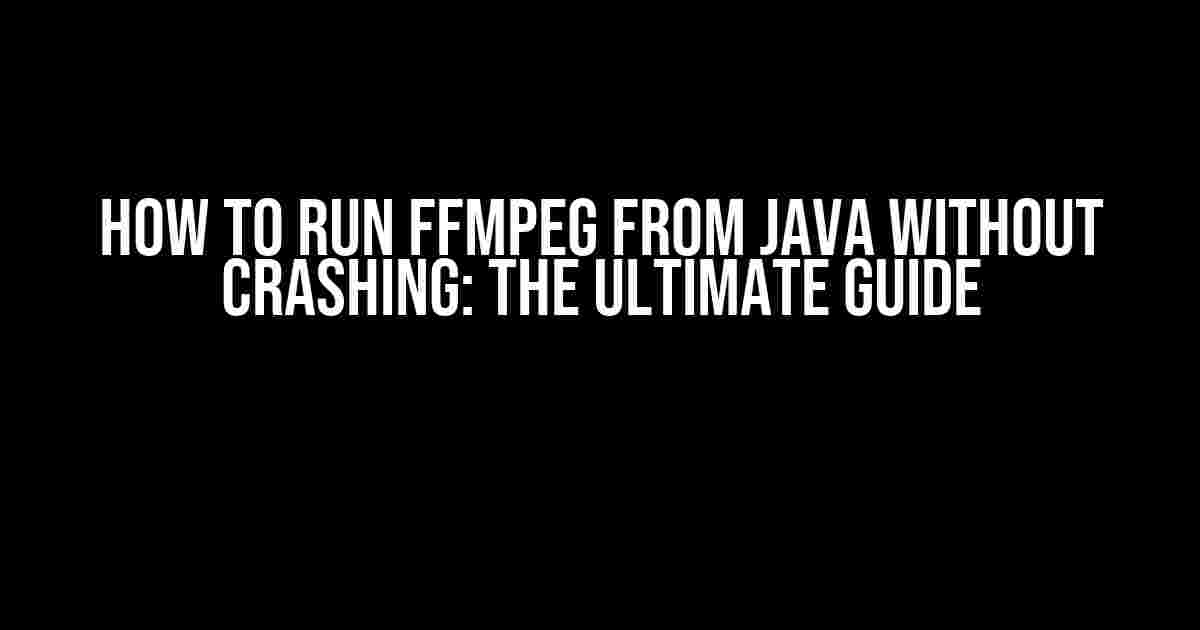FFmpeg, the powerful, open-source multimedia processing tool, has been a staple in the world of video and audio manipulation. But, when it comes to running FFmpeg from Java, things can get a bit tricky. You’ve probably encountered crashes, errors, and frustration. Fear not, dear developer! In this comprehensive guide, we’ll explore the dos and don’ts of running FFmpeg from Java, ensuring a smooth and crash-free experience.
Understanding FFmpeg and Java Integration
Before diving into the nitty-gritty, let’s briefly discuss how FFmpeg and Java interact. FFmpeg is a command-line tool, which means it’s designed to receive input from the command line and produce output accordingly. Java, on the other hand, is an object-oriented programming language. To bridge the gap between these two, we’ll use Java’s ProcessBuilder and Process classes to execute FFmpeg commands and capture the output.
The Challenge: Why Running FFmpeg from Java Can Be Problematic
- FFmpeg is a native application, which means it’s not part of the Java Virtual Machine (JVM). This introduces complexity when trying to interact with it from Java.
- FFmpeg’s output can be verbose, making it difficult to parse and interpret in Java.
- Platform differences can lead to compatibility issues, such as file path and encoding inconsistencies.
- Resource management becomes crucial, as FFmpeg can consume significant CPU and memory resources.
Step 1: Setting Up Your Environment
Before running FFmpeg from Java, ensure you have the following setup:
FFmpeginstalled on your system (download the correct version for your operating system).- A compatible
Java Development Kit (JDK)installed (version 8 or higher recommended). - Your Java project set up with the necessary dependencies (we’ll cover this later).
Configuring Your Java Project
In your Java project, add the following dependencies to your pom.xml file (if using Maven) or your build.gradle file (if using Gradle):
<dependencies>
<dependency>
<groupId>org.apache.commons</groupId>
<artifactId>commons-lang3</artifactId>
<version>3.12.0</version>
</dependency>
<dependency>
<groupId>org.apache.commons</groupId>
<artifactId>commons-io</artifactId>
<version>2.11.0</version>
</dependency>
</dependencies>
These dependencies will help with file management and string manipulation.
Step 2: Building the FFmpeg Command
To execute FFmpeg from Java, you’ll need to construct a valid FFmpeg command. This command should include the input file, output file, and any necessary options or filters.
A Basic FFmpeg Command Example
ffmpeg -i input.mp4 -c:v libx264 -crf 18 output.mp4
This command converts an input MP4 file to an H.264-encoded MP4 file with a constant rate factor (CRF) of 18.
Building the Command in Java
In Java, you’ll create an ArrayList<String> to store the command components:
List<String> command = new ArrayList<>();
command.add("ffmpeg");
command.add("-i");
command.add("input.mp4");
command.add("-c:v");
command.add("libx264");
command.add("-crf");
command.add("18");
command.add("output.mp4");
This list will be used to create a ProcessBuilder instance.
Step 3: Executing the FFmpeg Command
With the command built, it’s time to execute it using Java’s ProcessBuilder class:
ProcessBuilder processBuilder = new ProcessBuilder(command); processBuilder.redirectErrorStream(true); Process process = processBuilder.start();
The redirectErrorStream(true) method call is crucial, as it allows you to capture both the standard output and standard error streams from FFmpeg.
Handling the Output and Errors
To capture the output and errors, you’ll need to read from the InputStream objects returned by the Process object:
BufferedReader outputReader = new BufferedReader(new InputStreamReader(process.getInputStream()));
BufferedReader errorReader = new BufferedReader(new InputStreamReader(process.getErrorStream()));
String line;
while ((line = outputReader.readLine()) != null) {
System.out.println(line);
}
while ((line = errorReader.readLine()) != null) {
System.out.println(line);
}
This code reads and prints the output and error streams line by line.
Step 4: Managing Resources and Cleaning Up
When executing FFmpeg from Java, it’s essential to manage resources effectively to avoid memory leaks and crashes:
Waiting for the Process to Finish
process.waitFor();
This ensures that the Java program waits for the FFmpeg process to complete before continuing.
Closing Streams and Resources
outputReader.close(); errorReader.close();
Close the input streams and readers to free up resources.
Best Practices for Running FFmpeg from Java
To avoid common pitfalls when running FFmpeg from Java, keep the following best practices in mind:
| Best Practice | Description |
|---|---|
| Validate FFmpeg installation | Ensure FFmpeg is installed and accessible from your Java application. |
| Use absolute file paths | Avoid relative file paths, which can lead to compatibility issues. |
| Handle errors and exceptions | Capture and handle errors, exceptions, and crashes to ensure a robust application. |
| Manage resources effectively | Close streams, readers, and resources to prevent memory leaks and crashes. |
| Test and debug extensively | Thoroughly test and debug your application to identify and resolve issues. |
Conclusion
Running FFmpeg from Java doesn’t have to be a daunting task. By following the steps and best practices outlined in this guide, you’ll be well on your way to successfully executing FFmpeg commands from your Java application. Remember to stay vigilant, test extensively, and troubleshoot issues as they arise. Happy coding!
Now, go forth and conquer the world of multimedia processing with Java and FFmpeg!
Frequently Asked Question
When it comes to running FFmpeg from Java, many developers face the daunting task of avoiding crashes. Don’t worry, we’ve got you covered! Here are some frequently asked questions to help you navigate this complex process.
What is the best way to run FFmpeg from Java?
To run FFmpeg from Java, you can use the ProcessBuilder class or the Runtime.getRuntime().exec() method. These methods allow you to execute FFmpeg commands from within your Java application. However, be cautious when using these methods, as they can be prone to crashes if not handled properly. Make sure to handle the standard input, output, and error streams correctly to avoid crashes.
How do I handle the standard input, output, and error streams when running FFmpeg from Java?
To handle the standard input, output, and error streams, you can use the Process class’s getInputStream(), getOutputStream(), and getErrorStream() methods. These methods allow you to read from and write to the streams, which is essential for capturing the output of FFmpeg commands. You can also use a BufferedReader to read from the streams and a BufferedWriter to write to the streams.
What are some common mistakes to avoid when running FFmpeg from Java?
One common mistake is not handling the streams correctly, which can cause the FFmpeg process to hang or crash. Another mistake is not providing the correct path to the FFmpeg executable or not including the necessary dependencies. Additionally, not properly handling the output of FFmpeg commands can also lead to crashes. Make sure to test your code thoroughly to avoid these common mistakes.
How can I troubleshoot issues when running FFmpeg from Java?
To troubleshoot issues, you can use the FFmpeg command-line tool to test the command independently of your Java application. This can help you identify if the issue is with the FFmpeg command or with your Java code. You can also use a debugger or logging statements to track the execution of your Java code and identify the point of failure.
Are there any libraries or frameworks that can simplify running FFmpeg from Java?
Yes, there are several libraries and frameworks available that can simplify running FFmpeg from Java. For example, the JavaFFmpeg library provides a Java wrapper around the FFmpeg executable, making it easier to execute FFmpeg commands from within your Java application. Other libraries, such as JAVE (Java Audio/Video Engine), also provide a high-level API for working with FFmpeg.


